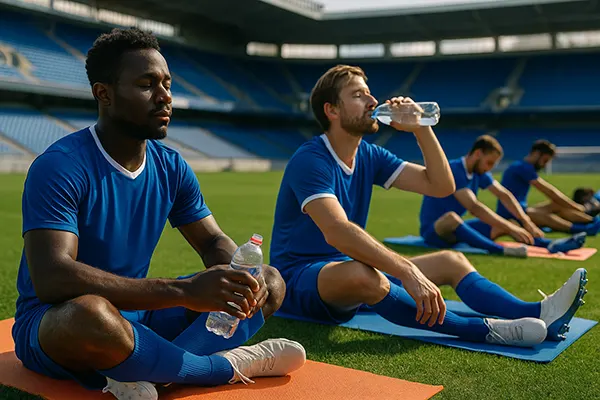Sports betting in 2025 has become increasingly data-driven, with fitness levels of athletes and teams playing a decisive role in outcomes. Understanding how training routines, congested match schedules and recovery strategies affect performance allows bettors to make informed decisions. Analysing these aspects goes beyond statistics, as physical readiness often determines success on the pitch and has a direct impact on bookmakers’ odds.
The Role of Training in Sports Performance
Training methods in modern professional sport are tailored to optimise player output across a long season. Clubs and national teams invest heavily in strength, conditioning, nutrition and injury prevention programmes. A player’s workload in training must balance intensity with the need to remain fresh for matches. When training cycles are designed efficiently, athletes can maintain peak performance levels for extended periods.
Sports scientists increasingly use wearable technology and biometric tracking to assess workload. Data on heart rate variability, sprint repetitions and muscle fatigue help coaches adjust training sessions. Bettors monitoring team reports and injury updates can gain insight into whether players are approaching a fixture in optimal condition.
Conversely, poorly managed training regimes can result in fatigue and a greater risk of injury. When players arrive on matchday below their physical best, this often reflects in the team’s overall energy, pressing intensity and ability to sustain performance over ninety minutes.
How Training Data Translates into Betting Markets
Bookmakers adjust odds based on reliable injury reports, player rotations and even pre-match press conferences that hint at training conditions. For example, a football club entering a Champions League tie after a reported high-intensity training camp may see odds shift due to expectations of strong physical readiness. On the other hand, when star players are said to be limited in training, markets may shorten odds on the opposition.
For bettors, tracking official team channels and credible sports journalism provides actionable insight. This analysis extends beyond headline injuries to include small details, such as reduced minutes in practice or modified warm-ups. Such information, while subtle, often influences outcomes more than raw form tables.
Ultimately, training quality is one of the hidden variables in sports betting. Recognising when a side is well-prepared or fatigued can be a decisive factor in predicting outcomes, especially in tightly contested fixtures.
Impact of the Match Calendar
Fixture congestion has become one of the defining features of elite sport. Football clubs, for instance, often face domestic league matches, cup competitions and continental tournaments within a short span. Similarly, basketball and tennis players endure intense travel schedules with minimal rest periods. This crowded calendar directly affects physical form, and in turn, betting outcomes.
When athletes are required to perform every three to four days, recovery time diminishes significantly. Fatigue accumulates, leading to reduced sharpness and increased likelihood of errors. Teams with deeper squads may rotate effectively, while others suffer performance dips. Understanding these dynamics is crucial for anyone assessing betting value.
Bettors who study fixture lists can anticipate which matches present higher risks of fatigue-induced underperformance. For instance, a team playing its third match in seven days may struggle against an opponent with a full week of rest. Such patterns often lead to unexpected results and valuable betting opportunities.
Calendar Pressure and Odds Adjustments
Bookmakers track fixture congestion closely and incorporate it into pricing models. Odds often reflect whether a club is entering a crucial away match after a demanding home fixture or long-distance travel. Savvy bettors can exploit discrepancies when bookmakers underestimate the cumulative impact of a packed schedule.
Recent examples in European football show that heavily rotated squads sometimes achieve better results than fatigued first-choice line-ups. This trend highlights the importance of squad depth and tactical flexibility, factors which are strongly linked to scheduling demands. Understanding these patterns can help bettors interpret odds shifts more accurately.
By cross-referencing fixture congestion with physical fitness data, bettors gain a comprehensive view. This dual approach makes it possible to identify situations where odds do not fully reflect the disadvantages imposed by the calendar.

Recovery and Its Importance in Sports Betting
Recovery strategies are as crucial as training in determining athletic success. Modern sports science emphasises rest, physiotherapy, cryotherapy and sleep monitoring to accelerate recovery between matches. Teams that excel in recovery management often outperform expectations during congested schedules, maintaining higher consistency levels across competitions.
Publicly available information about recovery can sometimes be limited, but media reports, player interviews and insider leaks provide valuable clues. When athletes confirm they are receiving reduced minutes or specialised treatment, bettors can infer the likelihood of sustained performance or potential absence from line-ups.
Moreover, recovery is not only physical but also psychological. Travel stress, mental fatigue and pressure from consecutive high-stakes games all reduce efficiency on the pitch. Bettors who consider both physical and mental recovery have a more complete picture of how form may fluctuate.
How Recovery Insights Affect Betting Markets
Odds often shorten when key players are confirmed to have fully recovered ahead of decisive fixtures. For example, a striker returning from a minor hamstring issue may significantly boost his team’s chances, prompting bookmakers to adjust prices. Conversely, when recovery updates remain uncertain, volatility in the betting market increases.
Monitoring official injury reports and the timing of player returns provides opportunities to anticipate odds movement before the broader market reacts. Bettors who act quickly on credible recovery news can capture greater value. This makes recovery analysis one of the most practical tools for predicting shifts in betting lines.
In 2025, as sports science continues to progress, recovery will remain a central component of both team strategies and betting analysis. The ability to interpret recovery indicators accurately distinguishes informed bettors from those relying solely on surface-level statistics.




